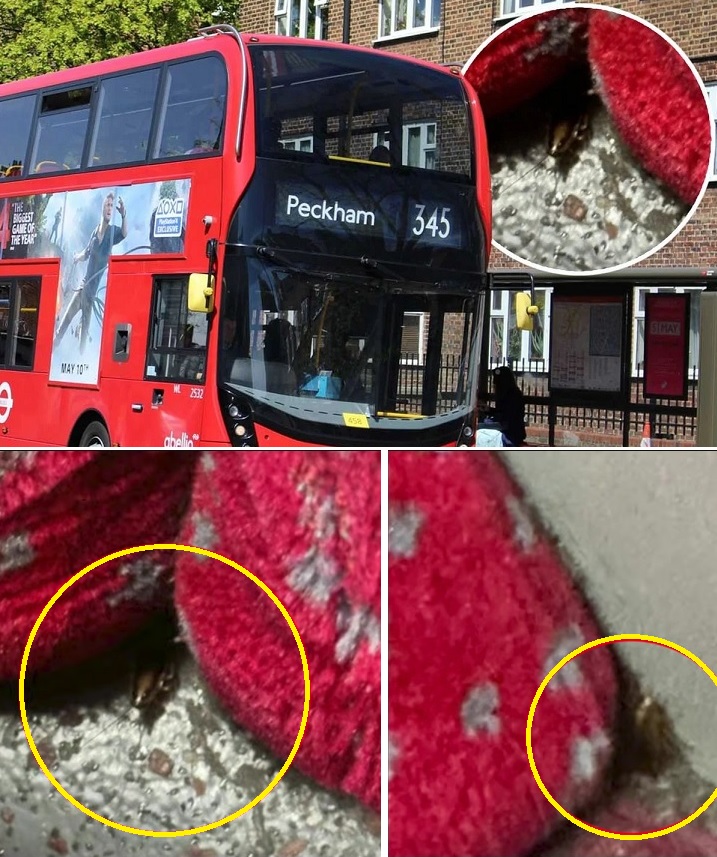You sip your morning coffee on the job, expecting a jolt of energy… but instead, something wriggles down your throat. 😱 What happens next? A London bus driver’s nightmare shift just went viral – and it’s making everyone rethink their commute.
(Imagine the horror: One wrong gulp, and your break turns into a full-body heave. But is this isolated, or a sign of something bigger plaguing public transport?)
Dive deeper into this stomach-churning story and see if your routes are safe. Click to read more:

A routine sip of water during a midday break turned into a driver’s worst nightmare on a bustling London bus route, sparking outrage over what campaigners are calling a “public health crisis” aboard the city’s iconic double-deckers. The incident, captured in a chilling firsthand account, has ignited a firestorm of complaints from Transport for London (TfL) staff, who claim cockroach infestations are turning their workspaces into breeding grounds for pests – and potentially passengers’ next unwanted travel companion.
The story broke wide open last week when a female driver on Route 159, running from Streatham to Oxford Circus, described the moment her refreshment became a horror show. “I went to take a sip from my drink and felt something in my mouth,” she recounted in a video shared by the London Bus Forums, a grassroots group advocating for driver welfare. “I spat it out and saw it was a cockroach. I felt sick and ended up vomiting.” The driver, who asked to remain anonymous amid fears of retaliation, said she was forced to clock out early and head home, her stomach churning from the revulsion. The bus in question, identified as LT160, had reportedly been flagged for pest issues multiple times before, yet it remained in service.
This isn’t a one-off gag from a bad horror flick. It’s the latest in a string of reports painting a grim picture of hygiene lapses across London’s sprawling bus network, which ferries over two million passengers daily. Videos and photos circulating online show the six-legged intruders scurrying across seats, under dashboards, and even into drivers’ food containers during breaks. One clip from October 8 depicts cockroaches boldly exploring a lunchbox in a staff rest area, while another captures them emerging from beneath seat cushions on a Route 345 bus near the Natural History Museum. “These aren’t just creepy crawlies – they’re a health hazard,” said Kevin Mustafa, a former bus driver turned safety campaigner with the London Bus Forums. “Drivers are finding them crawling in their cabs, on their legs, even in the places they eat. It’s untenable.”
The complaints zero in on three routes hardest hit: 159 (Streatham to Oxford Circus), 345 (Peckham to South Kensington), and 55 (Walthamstow to Oxford Circus). These lines snake through densely populated neighborhoods, where aging fleet vehicles and infrequent deep cleans are blamed for creating ideal conditions for the resilient insects. Cockroaches, known for their ability to survive in urban squalor, thrive in the warm, crumb-filled confines of public transport. Experts note that a single female can produce up to 400 offspring in her lifetime, turning a minor sighting into an infestation overnight.
TfL, the public body overseeing the capital’s buses, has acknowledged the uproar but downplayed its scope. “Cockroach occurrences are uncommon,” a spokesperson insisted in a statement released Monday, emphasizing that the network undergoes “extensive daily cleaning” and treatment with antibacterial products akin to those used on the Underground. The agency has launched an “immediate inquiry” and promised to deploy specialist pest control contractors where needed, potentially sidelining affected buses for inspections and fumigation. “We would like to reassure staff that our operators would never take action against people raising concerns about welfare or safety,” the statement added, urging drivers to report issues directly to employers or unions.
But skeptics aren’t buying the reassurance. Mustafa and his allies point to a “culture of fear” permeating the industry, where whistleblowers risk reprisals from management. “Drivers don’t like to report safety issues because they fear the management will target them for their job,” he told reporters. This sentiment echoes earlier scandals, including a 2024 whistleblower exposé revealing cockroaches in driver compartments on Arriva and Go-Ahead operated buses, alongside faulty equipment like snapped steering stalks. Back then, TfL faced accusations of underfunding maintenance while Mayor Sadiq Khan greenlit multimillion-pound pay hikes for Tube drivers – a disparity that’s resurfaced in today’s debate.
London’s buses aren’t privately owned by TfL; they’re franchised to operators like Stagecoach, Arriva (recently snapped up by a private equity firm), and Metroline. This setup, critics argue, incentivizes cost-cutting over cleanliness. “Buses are not being cleaned properly across the board,” Mustafa said, calling for mandatory deep cleans with insecticides and heat treatments at known hotspots. The London Bus Forums has penned a formal letter to transport bosses, demanding sealed barriers in pest-prone areas and more rigorous vacuuming protocols. Their push culminates in a planned march on November 5, Bonfire Night, where drivers will rally for the “Bus Drivers Bill of Rights” – a wishlist including better pay, safer cabs, and enforceable hygiene standards.
Public reaction has been visceral. Social media is ablaze with memes of red buses reimagined as “roach mobiles,” alongside passenger testimonials of spotting the bugs mid-ride. “I was on the 55 last week and saw one dash across my foot – nearly jumped out the window,” tweeted one commuter, while another quipped, “TfL’s new fare: £1.75 plus a side of salmonella.” Health experts are weighing in too, warning that cockroaches can spread bacteria like E. coli and salmonella via their droppings, posing risks to vulnerable riders like children and the elderly. “This is a public health issue affecting both staff and passengers,” a Forums spokesperson emphasized.
The infestation saga isn’t unique to London. Similar woes have plagued public transit worldwide: New York City’s subways have long battled rat and roach epidemics, while Sydney’s trains faced a 2023 outbreak tied to post-pandemic litter. In the UK, the NHS has grappled with vermin in hospitals, including “sewage leaks and crumbling ceilings” alongside cockroaches. What sets London’s case apart is the human element – drivers like the Route 159 veteran, whose story has humanized the headlines. “It was so terrible she went home sick,” Mustafa recounted of the affected driver. Her ordeal underscores a broader toll: distracted drivers losing focus as bugs climb windowsills, or worse, potential accidents from the revulsion.
As the investigation unfolds, TfL faces mounting pressure to act decisively. City Hall Conservatives, led by Neil Garratt AM, have slammed Khan’s administration for repeated safety oversights, from overheating cabs to speeding protocols. “We’ve raised these issues time and again,” Garratt said. On the flip side, unions like Unite the Union are mobilizing, vowing to shield reporters from backlash. “Swift, transparent action will restore trust,” Mustafa urged, echoing calls for accountability in a system that shuttles millions but seems to sideline the hands on the wheel.
For now, the driver who spat out terror is recovering at home, but her colleagues soldier on, eyes peeled for the next intruder. As winter looms, with its promise of huddled passengers and discarded wrappers, the question hangs: Will TfL fumigate the problem, or let it crawl unchecked? One thing’s certain – London’s buses, once a symbol of stiff-upper-lip reliability, are now synonymous with a six-legged scandal that’s hard to swallow.





